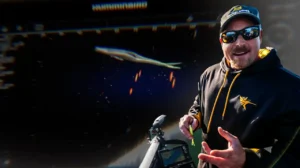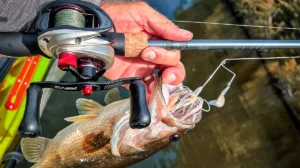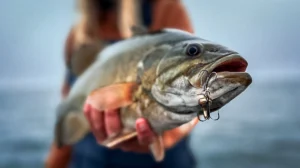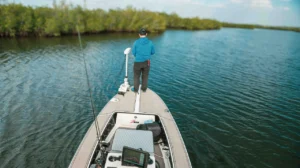While watching Bassmaster LIVE during the 2020 Bassmaster Classic, I picked up on an interesting moment between commentator Davy Hite, 1999 Bassmaster Classic Champ, and his guest Rick Clunn, four-time Bassmaster Classic Champ. The action had been slow at the time Clunn was welcomed on stage. There had been little to no action on all of Lake Guntersville in about an hour and a half. Which is astonishing enough in itself.
But the real puzzler was that the fish had been biting all over the lake and in rapid succession for 30 minutes prior to them shutting down. Lake Guntersville is a massive fishery and the anglers were stretched out for 50 miles, but somehow the fish were behaving the same throughout.
So the question arose, “What do you do when they’re not biting?” What a simple and profound question. In years past, when we didn’t have metrics from the likes of BassTrakk (Bassmaster’s unofficial live leaderboard), we’d notice lulls in our own fishing. But they were singular events in our minds. When the fish would stop biting, anglers would just write it off as pulling into the wrong pocket or having caught all the fish on a spot.
Now with glaringly obvious data, we know that it’s not just us, our fishing or our spots. There’s something larger at play. So I caught up with Clunn to get his take on why we see this shutdown and how he recommends targeting bass when they’re not biting.
Major and minor feeding periods
“It’s all pretty much theoretical, like most things are in life,” Clunn said. “If things are stable and the fish are biting during a major feeding period, what are you going to do the other six hours of the day?”
“Major feeding period.”
Admitting my own ignorance here, as much as I’ve fished, I have never paid attention to or honestly even heard about major and minor feeding periods. Not by name anyway, though I have picked up on some of the same things Clunn will mention here shortly. But to fill those in like me who are ignorant to this baseline, basically there are four windows each day in which wildlife are most likely to feed: two major feeding periods and two minor feeding periods.
All feeding periods are also relative to the moon. When the moon is on either horizon, there is a minor feeding period. When the moon is directly overhead or directly underfoot, there is a major feeding period. Clunn said tracking this goes all the way back to the Farmer’s Almanac but now there are also charts online.
I went back and looked up one such chart for Guntersville, Alabama on March 7th, the second day of the Bassmaster Classic and the day that Clunn was on set. One of the major feeding periods that day started at 9:55 a.m. and lasted until 11:55 a.m.; the same window in which Basstrakk lit up. Hite also mentioned in that segment that the better bite had been delayed about 30 minutes from the previous day. According to the chart, one of the major periods the day before started at 8:56 a.m., correlating with what actually transpired.
Now for some of you, especially the hunters, I know this is all elementary information. But for me, and I have to believe a few others out there, this is a “wow” moment; and I don’t get many of those anymore doing what I do for a living. And I don’t get the chance to discuss something like this with the likes of Rick Clunn very often either, so we dove in hard.
There are other visual indicators of the major and minor feeding periods as well. Clunn says to pay attention to the wildlife around you. Which is something my father has also always pointed out. When the fish are biting, you’ll often hear the birds singing, the frogs croaking or the squirrels scurrying around. When the woods around you are silent, the fishing is often times at a stand still as well.
“You can even see it in cattle at times, even though they are somewhat domesticated,” Clunn said. “Man has a tendency to throw things off those natural patterns through domestication. But there are things like that you can use to stay in tune with what’s going on out there.”
So taking into account the feeding periods, how do you decide when to go and when to stay? If you haven’t had a bite in 15 minutes, do you say “well it’s only been 15 minutes,” or do you pull the trolling motor and move?
“It’s kind of a guessing game,” Clunn said. “If the bite is aligning with the major and minor feeding periods, that’s a big help. Sometimes they don’t, though.”
Clunn cautioned here that I not get too carried away with this newfound information. The major and minor feeding periods are just one variable. Current generation schedules, weather changes and other variables will also affect the way fish feed.
“It’s only one variable and that’s always been the catch to it,” Clunn said. “You can say, ‘Hey, I’m going in this creek tomorrow. They were going nuts in there today during the major feeding period. Tomorrow the major feeding period is about 45 minutes later. I’m going to go in there and kill ’em.’ Then, all of a sudden, it rains all night and the creek muddies. That’s going to blowup that major/minor deal.”
“It’s a variable that seems to operate well under stable conditions.”
How to activate fish when they’re inactive
So what do you do to get bit when the conditions are stable and you are outside those feeding periods? How do you catch a fish when they’re not biting? That’s where Clunn really likes to get into the behavior of fish as a collective and the behavior of a fish individually. Essentially, where the psyche of a bass comes into play.
“I like to look for the outcast. The fish that’s been kicked out of the pack. For whatever reason, say he’s blind in one eye. And that’s a little extreme, but you look for those fish that are not hunting with the group. What that basically implies is that fish has to eat when food is available. He can’t wait for the major or minor feeding period.”
Clunn cautions that running away from your area isn’t necessarily the right move when you get outside of these feeding periods. If everything else is stable in your area, then you at least know you’re still around fish. If you run all over the lake when the fish aren’t actively feeding, you’ll have a hard time figuring out if you’re even around fish. You may be better off staying in your area and trying to figure out a way to trigger the devil you know.
Artificial feeding periods
Clunn also talked about how “artificial feeding periods” can be created by things like current generation. Something often seen on impoundments like Lake Guntersville on the Tennessee River where water inevitably has to flow.
Think about ledge tournaments in the summer: we often see the fish feed like crazy during the artificial feeding period created by current generation and then shutdown when the water turns off. That’s when the game becomes “What can I do to fire up the school?” One thing to keep in mind, dams aren’t the only thing that can move water.
“I had a place on Pickwick one time where I won an FLW event. Every single time a barge went by, it sucked water off the bank and then pushed water back up on it and they’d bite.”
I remember watching a similar situation unfold as an angler fished for schooling fish once upon a time. It was Greg Hackney in 2010 on the Alabama River, I believe. He was able to catch a few fish and then the bite would die. He would promptly crank his big motor, cut a few large donuts around where the fish had been surfacing, cut the engine off and run back to the front deck.
The noise of the big motor didn’t seem to phase the bass, but the disorienting effects of the sloshing waves sent the shad in every direction. This made the bass start chasing them again and he was able to catch a few more fish before they’d shut down and he’d repeat the process.
“Just by staying on a spot, you can start to figure out other little subtle things like that.”
Running and gunning
But, that’s not to say running and gunning won’t work as well.
“I even remember back when I guided,” Clunn said. “There’s a time in the day, especially fishing grass like you have at Guntersville, where they’re not biting. Since I was guiding, I knew a lot of good spots. So we’d move and the minute I’d pulled up to another spot, me or one of my clients would catch one or two. And boom, they’d just shut off immediately. Then we’d run to another spot and catch one or two and run back to that spot and catch a couple. So there’s a curiosity factor there too, that your boat movement was doing something to generate a few bites when you pull up to that weed bed.”
Clunn doubts he was actually generating enough current for the fish to feel, rather it was likely that his presence had heightened the senses of the bass and piqued their curiosity.
“Bass are very curious predators,” Clunn said. “It’s like us pulling up there would cause the fish to pull out to the edge of the weeds to investigate and all of a sudden a worm or something would fall in front of them and they’d bite it. Or maybe it’s that the baitfish moved.”
Naturally the bream in the area were likely inactive as well, so Clunn hypothesized that the mere presence of his boat might have moved some of them or distracted them.
“Anytime prey becomes distracted, it’s a trigger for the predator to strike.”
Clunn’s favorite bait when fish aren’t feeding
One answer that I was still digging for still eluded me.
Which bait would Rick Clunn use to try to trigger a fish to strike if he were going to hunker down and stay on the fish he located?
“Really you’re just looking for one or two extra fish between those feeding periods,” Clunn said. “And there are some baits that might trigger them if you stay on your area.”
In my mind, I immediately thought about something like a shaky head. Not because I love throwing it or even have that much confidence in it; I’ve just conducted hundreds of interviews over the years and if I had to guess what an angler was going to suggest when the bite gets tough, it would be a shaky head. Then a dropshot, a Ned rig or a Neko rig maybe. However, I was surprised and delighted by Clunn’s answer.
“It’s important to understand the predator/prey relationship,” Clunn said. “We’ll use the analogy of a lion sitting there watching a herd of impala. Even if he’s active, he tries to pick the young or the weak. He uses the laws of conservation of energy. Which one can he get and receive the most energy from with the least effort or injury?
“This is why topwater may be the best bait to throw during those time frames when the fish aren’t biting. Because you’re really pulling that predator’s strings. He’s sitting there like, ‘Dang, that’s weak. I’m supposed to eliminate it.’ Because a predator’s role is to eliminate anything that’s weak. And all of a sudden that topwater is easy, it looks fairly large and he’s supposed to eliminate it.
“Predators were not designed to eat the whole herd. Remember the Lion King? It kind of works off of that a little bit. Yes, they’re out there to eat the impala, but they’re not there to destroy the whole herd. Their presence should make the herd healthier by eliminating the weak. So that’s why one of my favorite choices in that time frame is a topwater.”
The proverbial circle of life. Rick Clunn throws a topwater when the fish aren’t biting because of the Lion King. And that’s one of the many reasons Rick Clunn is better than you or I ever will be. One of the reasons he is one of the best and most loved anglers in the world. He has a far deeper spirit and grasp on things than most of us will ever even glimpse. Thanks for taking the time, Clunn. We all appreciate the glimpse.

















